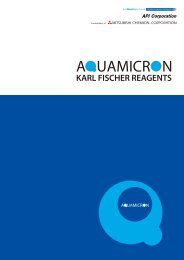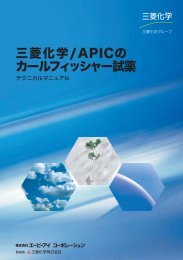Development of Karl Fischer Reagents
Development of Karl Fischer Reagents
Development of Karl Fischer Reagents
Create successful ePaper yourself
Turn your PDF publications into a flip-book with our unique Google optimized e-Paper software.
I-1. Questions & Answers about <strong>Karl</strong> <strong>Fischer</strong> <strong>Reagents</strong><br />
(1) Volumetric titration<br />
(2) Coulometric titration<br />
Your choice should reflect a proper understanding <strong>of</strong> each method. It is also<br />
essential to use the appropriate reagent in each case. The following table<br />
compares the characteristics <strong>of</strong> each method.<br />
Principle<br />
Titration reagents<br />
Characteristics<br />
2. Titration Equipment<br />
With <strong>Karl</strong> <strong>Fischer</strong> titration, electrical detection methods are used to<br />
determine the end point. It is important to use the following types <strong>of</strong> titration<br />
equipment.<br />
Volumetric titration : Automatic volumetric moisture meter<br />
Coulometric titration : Automatic coulometric moisture meter<br />
There are now convenient automatic moisture measurement systems<br />
designed for ease <strong>of</strong> operation.<br />
As <strong>Karl</strong> <strong>Fischer</strong> reagents are affected by atmospheric moisture, an airtight<br />
titration cell must be used.<br />
For your information<br />
1. Unlike standard volumetric analysis, it is not possible with <strong>Karl</strong> <strong>Fischer</strong><br />
titration simply to fill a buret with <strong>Karl</strong> <strong>Fischer</strong> reagent and add it one drop<br />
12<br />
Item Volumetric titration Coulometric titration<br />
A method <strong>of</strong> volumetric analysis used to<br />
determine moisture content from the<br />
titrated amount <strong>of</strong> <strong>Karl</strong> <strong>Fischer</strong> reagent<br />
<strong>Karl</strong> <strong>Fischer</strong> reagent and titration solvent<br />
(dehydrated solvent)<br />
1) Since a <strong>Karl</strong> <strong>Fischer</strong> reagent is used as<br />
the titration agent, the titer must be<br />
known in advance.<br />
2) A wide range <strong>of</strong> reagents can be used<br />
as various dehydrating agents are<br />
available.<br />
3) The method can be used to measure<br />
moisture content across a wide range.<br />
However, it is not suitable at the<br />
microgram level.<br />
Iodine produced through electrolytic<br />
oxidation undergoes a KF reaction with<br />
water. Moisture content is determined by<br />
measuring the amount <strong>of</strong> electricity<br />
required to the point where excess<br />
iodine is produced.<br />
Anolyte and catholyte<br />
1) The factors measured are current and<br />
time. Since electrons act as the titration<br />
agent, a standard solution is not<br />
required. The method allows<br />
measurement <strong>of</strong> absolute quantities<br />
based on the Faraday constant.<br />
2) The same anolyte can be used<br />
repeatedly.<br />
3) The method is effective for measuring<br />
minute amounts <strong>of</strong> water. Electricity<br />
can be measured in tiny increments,<br />
so it is possible to measure water in<br />
quantities <strong>of</strong> a ug




